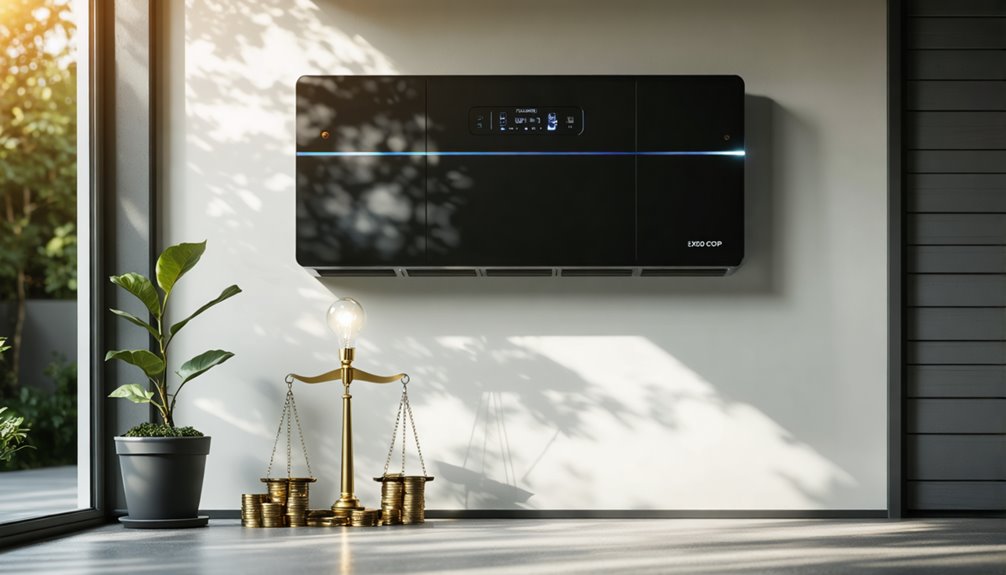You’re looking at a $6,000 to $18,000 investment when you consider solar batteries. That’s a hefty price tag. But homeowners are reporting up to 70% cuts in their monthly power bills. Plus, there’s a 30% federal tax credit available. The math gets complicated when you factor in backup power during outages and environmental benefits. Whether they’re worth it depends on several key factors that might surprise you.
How Much Do Solar Batteries Cost in 2025?
Solar battery prices in 2025 vary widely based on what you need for your home. The cost of solar batteries typically runs from $6,000 to $18,000 total. You’ll pay about $1,300 per kWh before the federal tax credit kicks in. That drops to around $1,000 per kWh after the 30% credit.
Here’s what solar battery costs look like: A 5 kWh energy storage system runs $6,500, or $5,000 after credits. A bigger 40 kWh solar storage setup costs $52,000, dropping to $40,000 with credits. The average cost for a typical 13.5 kWh system lands at $13,500 after the credit.
Your installation costs depend on several factors. DC versus AC batteries affect pricing. The system’s size and how complex the installation is also change your final bill. Additionally, factors like battery chemistry (lithium-ion vs. lead-acid) can significantly impact overall costs, with lithium-ion being more popular due to its efficiency and longevity compared to lead-acid batteries.
Solar Battery Price Breakdown by Capacity
Breaking down costs by battery size helps you understand what you’re paying for. Solar battery prices vary widely based on storage capacity. A 5 kWh system costs about $6,500 before incentives. After the federal tax credit, you’ll pay around $5,000. Larger systems cost more upfront. A 40 kWh solar battery storage system runs $52,000, dropping to $40,000 with the credit.
The cost per kWh tells a different story. Before incentives, you’re looking at $1,300 per kWh. The federal tax credit brings this down to $1,000. Bigger batteries offer better value per kWh, which could mean greater energy savings over time. Installation costs add another $2,000 to $3,500 to your total bill, depending on how complex your system is.
It’s important to consider battery chemistry differences when choosing a solar battery, as factors like lifespan, efficiency, and depth of discharge can vary between lithium-ion and LFP options.
Popular Solar Battery Models and Their Costs
Battery brands compete hard for your home energy storage business. The Tesla Powerwall leads among popular solar battery models with its $9,200 price tag and 13.5 kWh capacity. It’s become a household name in solar batteries cost discussions.
The Enphase IQ 10 costs $10,000 and stores 10 kWh of power. Meanwhile, the SolarEdge Home Battery runs $9,000 and works seamlessly with SolarEdge inverters.
Generac PWRcell offers the lowest price at $8,000 for 9 kWh of storage. It’s gained popularity for essential backup power needs.
The LG Chem Prime rounds out the top choices at $9,500. Users praise its efficiency and compatibility with various solar systems. When purchasing solar batteries, it’s important to consider warranty terms to ensure long-term performance and support. These five models dominate today’s residential solar battery market.
Federal Tax Credits and State Incentives
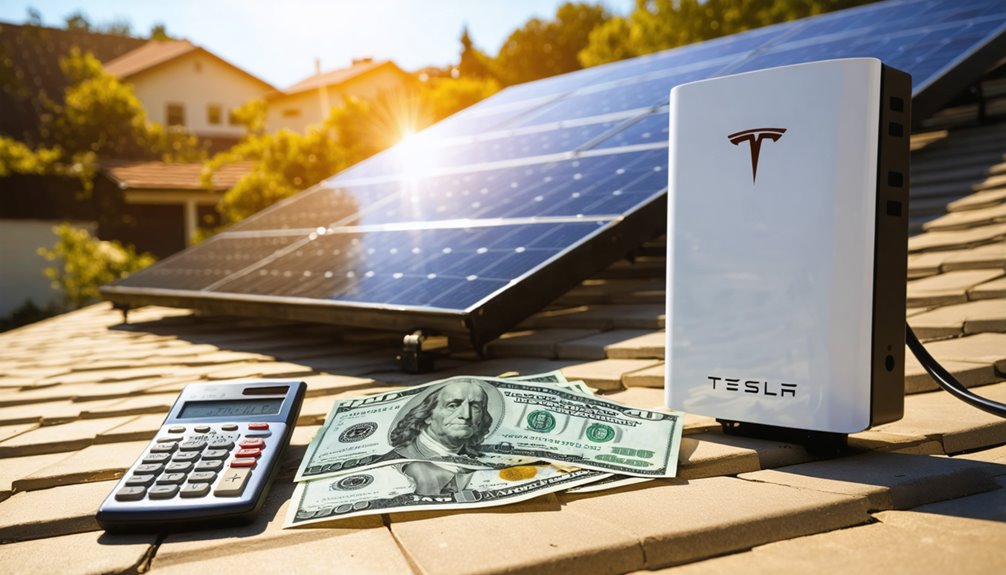
You can cut your solar battery costs by thousands of dollars through government programs. The federal tax credit covers 30% of your installation costs, while many states offer their own cash rebates and incentives. These programs vary by location and have different rules about who qualifies and when they expire.
Federal Tax Credit Details
When homeowners install solar batteries, they’re eligible for a federal tax credit that cuts 30% off their total costs. This credit reduces your federal income taxes based on your solar battery installations expenses.
Here’s how it works: If your installation costs total $13,500, you’ll save $4,050. That brings your overall investment down to $9,450. The federal government designed these financial incentives to make solar batteries worth considering for more families.
You’ve got until December 31, 2025, to claim this 30% credit. After that date, the percentage drops. Many states add their own incentive programs on top. California’s SGIP program, for instance, offers extra money for energy storage systems. These combined benefits can slash your upfront costs even more.
State Rebate Programs
Beyond the federal tax credit, state programs offer additional ways to save money on solar battery installations. California’s Self-Generation Incentive Program and Maryland’s tax credit help reduce upfront costs considerably. These state rebate programs work alongside the federal solar tax credit to create bigger savings for homeowners.
| State | Program Name | Benefit |
|---|---|---|
| California | SGIP | Direct rebates |
| Maryland | Tax Credit | State tax reduction |
| New York | NY-Sun | Cash incentives |
| Massachusetts | SMART | Performance payments |
| Hawaii | Tax Credit | 35% credit |
Local utility incentives vary by location, so you’ll need to check what’s available in your area. Virtual power plants also pay homeowners for stored energy during peak times. These programs boost energy security while creating extra income from your solar battery investment.
Installation Costs and Labor Considerations
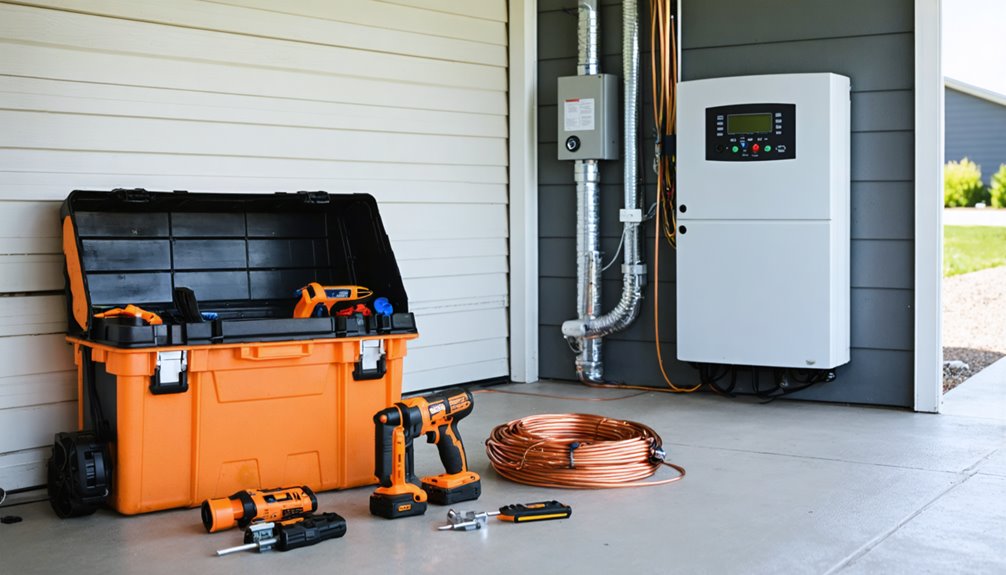
Installing solar batteries comes with significant upfront costs that can surprise homeowners. You’ll typically pay between $12,000 and $20,000 for total installation costs. This includes the battery pricing and labor costs. Popular models like Tesla Powerwall cost around $9,200, while SolarEdge and Generac units range from $8,000 to $9,000.
Labor costs add another $2,000 to $3,500 to your bill. If you’re adding batteries to existing solar panel systems, you’ll face higher costs. Additional expenses include electrical upgrades and permit fees. Installing batteries separately from your energy system costs more than doing both together.
Your final price depends on several factors. These include your location, the battery’s capacity, and how complex it is to connect to your current setup. For businesses in off-grid locations, solar batteries provide reliable energy and can be invaluable for maintaining continuous operations.
How Solar Batteries Store and Deliver Energy
Solar batteries work like rechargeable phone batteries, but they’re much bigger and more powerful. When your solar panels make excess solar energy during sunny days, it flows into these lithium-ion batteries for energy storage. You’ll find most home solar batteries store between 5 and 40 kilowatt-hours of electricity. That’s enough stored solar power to run your essential appliances for hours or even days. During evenings or power outages, your battery becomes a backup power source, sending electricity back to your home. Modern systems track your energy usage with smart monitors. They’ll automatically decide when to store power and when to release it. This helps you use electricity more efficiently throughout the day and night. Additionally, solar batteries offer benefits of energy independence, allowing homeowners to rely less on the grid and more on their own generated power.
Calculating Your Return on Investment
You’ll want to know when your solar battery investment pays for itself and how much money you’ll save over time. Most homeowners see their batteries pay back the initial cost within 5 to 10 years, depending on their energy use and local electricity rates. Your total savings include lower monthly bills, tax credits worth about $4,500, and possible earnings from selling extra power back to the grid. It’s important to consider that battery specifications, such as capacity and depth of discharge, significantly influence the number of batteries needed and your potential savings.
Payback Period Analysis
When calculating whether solar batteries make financial sense, the payback period typically falls between 5 and 10 years. Your actual timeline depends on several factors. Installation costs, local energy rates, and how much you’ll save each month all play a role.
Most homeowners see an ROI around 30% when they include tax credits and energy savings. Some households save over $1,000 annually, especially if they use lots of power during peak hours or face frequent outages.
You’ll need to evaluate the battery’s lifespan, which runs 5 to 15 years. Maintenance costs can also affect your returns. If your area offers full-retail net metering, where you can sell excess power back to the grid, solar batteries might provide less financial benefit.
Total Savings Calculation
Beyond payback periods, understanding your total savings requires looking at the complete financial picture. You’ll need to evaluate how solar battery worth connects to your yearly energy costs.
The price of solar batteries starts around $13,500, but federal tax credits drop that to $9,450. Once installed, these systems can reduce your electricity bills by over $1,000 each year. That’s because solar energy storage lets you use stored power during expensive peak hours.
Your total savings depend on local electricity rates and how much energy you use. Some homeowners earn extra money through energy-sharing programs. They sell excess power back to the grid.
As electricity costs rise and battery prices fall, your savings could grow even larger over time.
Energy Bill Savings With Battery Storage
How much can solar batteries really save on electricity bills? You can cut monthly energy bills by up to 70% with stored energy from a solar battery. By using your battery during peak hours, you’ll reduce grid reliance and save money when electricity costs the most. If you join energy-sharing programs, you might earn financial rewards over $1,000 yearly. Net metering programs let you send excess power back to the grid for credits. This means even more energy bill savings throughout the year. The lifespan of solar batteries can vary, with street light solar batteries generally having shorter lifespans of 3-7 years due to constant cycling and outdoor exposure. The payback period for solar batteries typically runs 5 to 10 years. After that, you’re fundamentally getting free electricity from your stored solar power. Your actual savings depend on how you use energy and your local rates.
Backup Power Benefits During Outages
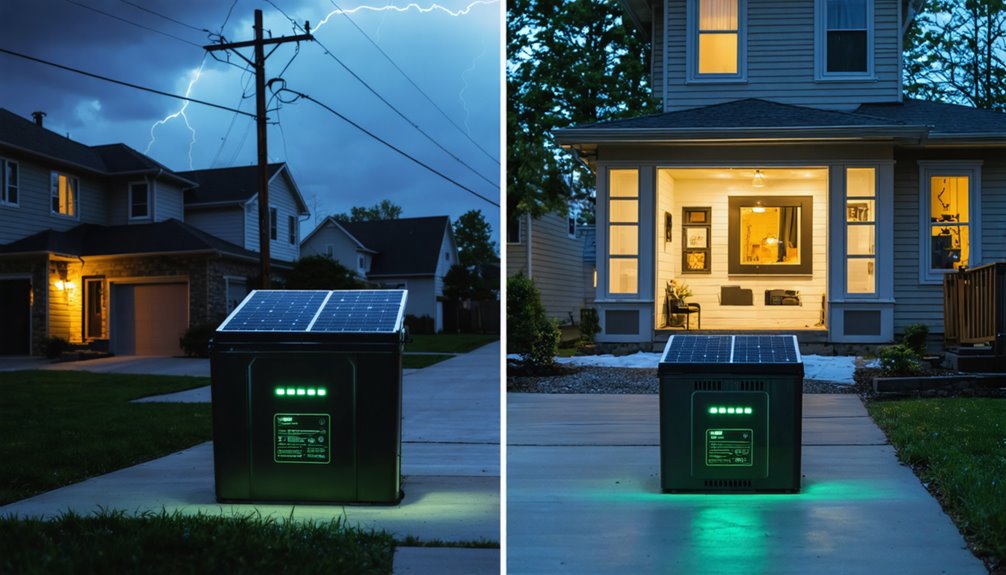
While your solar panels can’t work during a blackout without battery backup, solar batteries keep your power running when the grid goes down. You’ll get backup power within milliseconds when outages hit. Your battery won’t run everything, but it’ll handle critical loads like refrigerators, lights, and medical equipment.
This energy resilience matters most if you live where power cuts happen often. You’re storing extra solar energy during the day to use when you need it most. That means you’ve got energy independence from the grid’s problems.
Many homeowners say the peace of mind alone makes batteries worthwhile. You won’t worry about spoiled food or lost heating when storms knock out power lines. Your essential appliances keep running automatically without you lifting a finger. It’s crucial to ensure that proper system configuration and settings are in place to maximize the efficiency and reliability of your solar battery system.
Time-of-Use Rate Optimization
Your battery’s smart software works around the clock to save you money on time-of-use electricity rates. These rates can jump from $0.20 to $0.60 per kWh during peak demand hours. Solar batteries store energy when it’s cheap and release stored solar energy when prices spike. This strategy helps reduce reliance on expensive grid power. Homeowners report energy savings exceeding $1,000 yearly in areas with steep peak pricing. The batteries discharge automatically during high-rate periods, cutting electricity costs considerably. Some systems help families use up to 90% of their solar power instead of selling it back cheaply. That’s a big boost in financial efficiency. With proper management, these batteries turn time-of-use rates from a burden into an opportunity. For the optimal placement of solar panels, it’s crucial to position them where they can capture maximum sunlight, enhancing the overall efficiency of your solar system.
Environmental Impact and Carbon Footprint Reduction
Your solar battery doesn’t just save money it’s also fighting climate change. By storing extra solar power for later use, you’re cutting down on fossil fuel electricity from the grid and shrinking your carbon footprint. When you use your own clean energy instead of pulling from power plants that might burn coal or gas, you’re helping reduce the greenhouse gases that warm our planet.
Carbon Footprint Reduction Benefits
When homeowners install solar batteries with their panels, they’re making a significant dent in their carbon footprint. These energy storage systems help you use more renewable energy from your panels instead of pulling power from fossil fuels.
Solar batteries store clean energy when you don’t need it. Later, you’ll use this stored power instead of grid electricity that often comes from coal or gas plants. This switch cuts carbon emissions, especially during peak hours when utilities fire up their dirtiest power plants.
The environmental benefits add up quickly. You’re not just reducing your own emissions you’re helping create a cleaner energy grid for everyone. As more people adopt solar batteries, the nationwide impact on carbon reduction grows stronger.
Clean Energy Storage Impact
The way solar batteries store and distribute clean energy has changed how homes impact the environment. You’ll find these storage systems now capture extra power from solar panels during sunny days. Your home can then use this saved energy at night instead of pulling from the grid.
These batteries reduce reliance on fossil fuels by keeping clean energy available when you need it most. Your carbon footprints shrink because you’re using stored solar power during peak hours. Many regions still depend on coal or gas plants for grid electricity.
Financial incentives make solar battery adoption easier for homeowners. Tax credits and rebates lower the cost barrier. As more people install these residential energy solutions, communities build cleaner power networks that cut greenhouse gas emissions.
Battery Lifespan and Warranty Considerations
Before investing in solar batteries, you’ll want to know how long they’ll last and what protection you’ll get. Battery lifespan typically ranges from 5 to 15 years. Lithium-ion batteries usually last longer than lead-acid types.
Most manufacturers show confidence in their products through warranty coverage. They’ll guarantee about 70% capacity after 10-12 years. Warranty considerations vary by brand, typically lasting 5 to 10 years.
You’ll need to factor in replacement costs as part of your long-term investment. Older batteries won’t perform as well over time. Regular monitoring helps guarantee they’re meeting expectations. Some batteries might even outlast their warranties with proper care. When choosing a battery, you’ll find significant differences in manufacturer confidence and warranty terms between brands.
It’s essential to choose weather-resistant rechargeable batteries specifically designed for solar applications when considering replacements.
When Solar Batteries Make Financial Sense
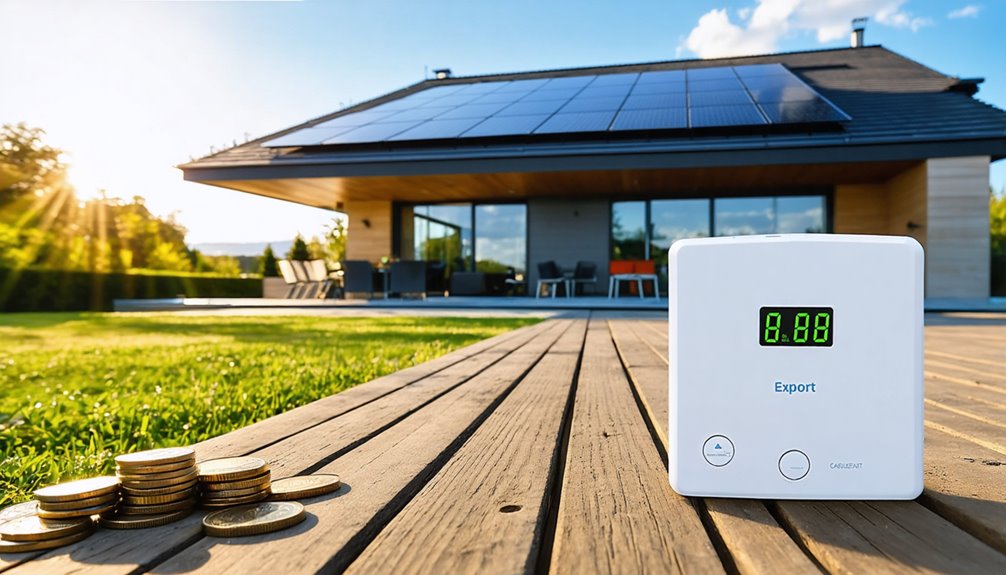
If you’re wondering whether solar batteries make financial sense, you’ll find the answer depends on where you live and how you use electricity. Areas with high electricity rates or poor net metering policies create stronger financial appeal for batteries. You’ll see energy savings by storing power for expensive peak hours.
Installation costs average $1,000 per kWh after the 30% federal tax credit. Your payback period typically runs 5 to 10 years. Energy-sharing programs can add over $1,000 yearly to your pocket.
Solar batteries boost self-consumption of your solar energy. You’ll use less grid power during costly hours, cutting electricity bills. They’re especially valuable in regions where utility rates spike during peak times or where blackouts happen frequently.
Comparing Battery Storage to Net Metering Options
Net metering and battery storage work differently when handling your extra solar power. Net metering lets you sell excess energy back to the grid for credits. Solar batteries store that energy for later use. Your choice depends on local policies and energy usage patterns.
| Feature | Net Metering | Solar Batteries |
|---|---|---|
| Energy Costs | Credits offset bills | Use stored energy during peak pricing |
| Backup Power | No protection during outages | Provides power when grid fails |
| Grid Electricity Prices | Sell at utility rates | Avoid buying expensive electricity |
In areas with good net metering policies, you’ll get fair compensation for surplus power. But you won’t have backup power during outages. Solar battery efficiency can boost savings when grid electricity prices exceed net metering credits. You’ll need to check your local utility rates and incentive programs to determine what’s best.
Conclusion
Solar batteries represent a major financial decision for homeowners. You’ll pay $6,000 to $18,000 upfront, but you can claim a 30% federal tax credit. Your monthly energy bills might drop by up to 70%. These batteries typically last 10-15 years with warranties. They’re most valuable if you live where electricity costs are high, experience frequent outages, or can’t use net metering. The investment often pays off through long-term savings and energy independence.

